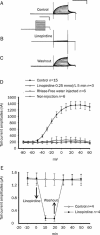Functional study of the effect of phosphatase inhibitors on KCNQ4 channels expressed in Xenopus oocytes
- PMID: 19701239
- PMCID: PMC4007189
- DOI: 10.1038/aps.2009.117
Functional study of the effect of phosphatase inhibitors on KCNQ4 channels expressed in Xenopus oocytes
Abstract
Aim: KCNQ4 channels play an important part in adjusting the function of cochlear outer hair cells. The aim of this study was to investigate the effects of ser/thr phosphatase inhibitors on human KCNQ4 channels expressed in Xenopuslaevis oocytes.
Methods: Synthetic cRNA encoding human KCNQ4 channels was injected into Xenopus oocytes. We used a two-electrode voltage clamp to measure the ion currents in the oocytes.
Results: Wild-type KCNQ4 expressed in Xenopus oocytes showed the typical properties of slow activation kinetics and low threshold activation. The outward K(+) current was almost completely blocked by a KCNQ4 blocker, linopirdine (0.25 mmol/L). BIMI (a PKC inhibitor) prevented the effects of PMA (a PKC activator) on the KCNQ4 current, indicating that PKC may be involved in the regulation of KCNQ4 expressed in the Xenopus oocyte system. Treatment with the ser/thr phosphatase inhibitors, cyclosporine (2 micromol/L), calyculin A (2 micromol/L) or okadaic acid (1 micromol/L), caused a significant positive shift in V(1/2) and a decrease in the conductance of KCNQ4 channels. The V(1/2) was shifted from -14.6+/-0.5 to -6.4+/-0.4 mV by cyclosporine, -18.8+/-0.5 to -9.2+/-0.4 mV by calyculin A, and -14.1+/-0.5 to -0.7+/-0.6 mV by okadaic acid. Moreover, the effects of these phosphatase inhibitors (okadaic acid or calyculin A) on the induction of a positive shift of V(1/2) were augmented by further addition of PMA.
Conclusion: These results indicate that ser/thr phosphatase inhibitors can induce a shift to more positive potentials of the activation curve of the KCNQ4 current. It is highly likely that the phosphatase functions to balance the phosphorylated state of substrate protein and thus has an important role in the regulation of human KCNQ4 channels expressed in Xenopus oocytes.
Figures




Similar articles
-
Studies of the effect of ionomycin on the KCNQ4 channel expressed in Xenopus oocytes.Biochem Biophys Res Commun. 2006 Sep 15;348(1):295-300. doi: 10.1016/j.bbrc.2006.07.053. Epub 2006 Jul 20. Biochem Biophys Res Commun. 2006. PMID: 16876114
-
Down-regulation of Na-K-Cl cotransport by protein kinase C is mediated by protein phosphatase 1 in pigmented ciliary epithelial cells.Exp Eye Res. 2001 Apr;72(4):371-9. doi: 10.1006/exer.2000.0966. Exp Eye Res. 2001. PMID: 11273665
-
KCNQ4 channels expressed in mammalian cells: functional characteristics and pharmacology.Am J Physiol Cell Physiol. 2001 Apr;280(4):C859-66. doi: 10.1152/ajpcell.2001.280.4.C859. Am J Physiol Cell Physiol. 2001. PMID: 11245603
-
Protein kinase C shifts the voltage dependence of KCNQ/M channels expressed in Xenopus oocytes.J Physiol. 2005 Nov 15;569(Pt 1):59-74. doi: 10.1113/jphysiol.2005.094995. Epub 2005 Sep 22. J Physiol. 2005. PMID: 16179364 Free PMC article.
-
Regulation of KCNQ4 potassium channel prepulse dependence and current amplitude by SGK1 in Xenopus oocytes.Cell Physiol Biochem. 2005;16(4-6):255-62. doi: 10.1159/000089851. Cell Physiol Biochem. 2005. PMID: 16301825
Cited by
-
Computational modeling reveals key contributions of KCNQ and hERG currents to the malleability of uterine action potentials underpinning labor.PLoS One. 2014 Dec 4;9(12):e114034. doi: 10.1371/journal.pone.0114034. eCollection 2014. PLoS One. 2014. PMID: 25474527 Free PMC article.
-
Action potential bursts in central snail neurons elicited by paeonol: roles of ionic currents.Acta Pharmacol Sin. 2010 Dec;31(12):1553-63. doi: 10.1038/aps.2010.156. Epub 2010 Nov 1. Acta Pharmacol Sin. 2010. PMID: 21042287 Free PMC article.
-
Proteoliposomes reconstituted with human aquaporin-1 reveal novel single-ion-channel properties.Biophys Rep (N Y). 2023 Jan 14;3(1):100100. doi: 10.1016/j.bpr.2023.100100. eCollection 2023 Mar 8. Biophys Rep (N Y). 2023. PMID: 36949749 Free PMC article.
References
-
- Kubisch C, Schroeder BC, Friedrich T, Lutjohann B, El-Amraoui A, Marlin S, et al. KCNQ4, a novel potassium channel expressed in sensory outer hair cells is, mutated in dominant deafness. Cell. 1999;96:437–46. - PubMed
-
- Gutman GA, Chandy KG, Adelman JP, Aiyar J, Bayliss DA, Clapham DE, et al. International Union of Pharmacology. XLI. Compendium of voltage-gated ion channels: potassium channels. Pharmacol Rev. 2003;55:583–6. - PubMed
-
- Marrion NV. Control of M-current. Annu Rev Physiol. 1997;59:483–504. - PubMed
Publication types
MeSH terms
Substances
LinkOut - more resources
Full Text Sources

